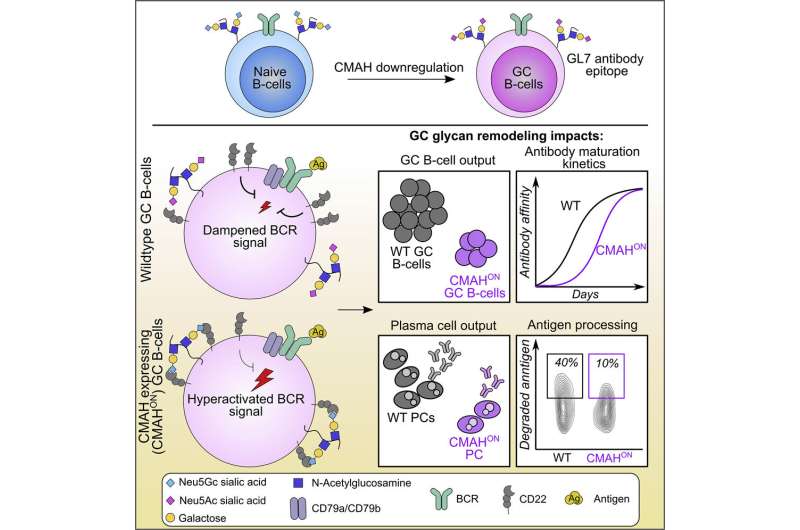New research reveals clues to how antibodies become fine-tuned to fight infection

Researchers at the University of Alberta have uncovered new information about a cellular mechanism in the immune system that provides a critical step toward better understanding how antibodies evolve and improve in the human body.
The antibodies our immune system produces need fine-tuning to reach maximum effectiveness. When a vaccine or pathogen is first introduced into our bodies, antibodies produced against these agents help protect us—but need to be optimized, explained Matthew Macauley, assistant professor in the Department of Chemistry.
"Slowly, our immune system improves the ability of the antibod[ies] to recognize their target, and makes them better and better," he said.
In a process called antibody affinity maturation, antibodies become better by evolving to bind more tightly to their target. This process occurs through mutations in a pseudo-random fashion. Then, as Macauley explained, in a highly orchestrated series of events, mutations that improve antibodies' ability to recognize their target are selected.
Getting to the center of how antibodies adapt
The complex process of selecting the best antibody happens in the germinal center, in a process called the germinal center reaction. If the goal is to be able to make vaccines even more effective and durable, scientists need to better understand this important location and the process of how they evolve, said Ph.D. candidate Jhon Enterina, who was the first author on the study.
One standard approach immunologists have used to study the germinal center for the past 20 to 30 years has been to look at specific carbohydrates on the surface of the white blood cells in the germinal center as an identifying marker. Macauley, whose research as a network investigator with the pan-Canadian research network GlycoNet focuses on carbohydrates, took notice of this.
"We began asking ourselves, do these carbohydrates have a function? They're probably not just there for us to identify, they're likely serving an important role."
B cells are the type of white blood cell that make antibodies. When B cells recognize a component of a vaccine or pathogen, it causes B cells to morph into more specialized germinal center B cells. It is these specialized cells that have a unique set of carbohydrates on their surface. That's where Macauley saw an opportunity to get to the bottom of the process.
"As the carbohydrates are changing in the germinal center into a different type, we came up with a fairly simple way to test for their function: Just stop them from changing and see what happens," he said.
Macauley and his team created a specific model to prevent the changes from occurring. "This was accomplished at the genetic level. Normally an enzyme gets turned off in germinal center B cells, so we simply didn't allow the cells to turn it off."
In doing so, they found key information about the mechanisms taking place in the germinal center.
"We connected those changes to a protein receptor called CD22 that recognizes the key carbohydrates."
The germinal center is especially challenging to study because it can't readily be studied in a petri dish. Once germinal center cells are taken outside of their natural environment in the body, they die within a few hours. Additionally, the cells within the germinal center divide at the fastest rate of all mammalian cells, even faster than cancer cells.
The reason these cells divide so rapidly is that it's critical for our bodies to evolve antibodies as fast as possible to neutralize pathogens before it's too late, said Macauley.
Many diseases, such as cancer or autoimmune diseases, stem from the germinal center getting out of control. However, before scientists are able to find out how to control this key area in the body, "we need to know what proper controls are in the first place, and are still a long ways from having all the answers," noted Macauley.
"It's a very complex process. And despite all of the insights that have been made in the last 10 years, there are still many questions about the germinal center, so this is providing another insight into one of the mechanisms that controls it."
More information: Jhon R. Enterina et al, Coordinated changes in glycosylation regulate the germinal center through CD22, Cell Reports (2022). DOI: 10.1016/j.celrep.2022.110512
Journal information: Cell Reports
Provided by University of Alberta




















